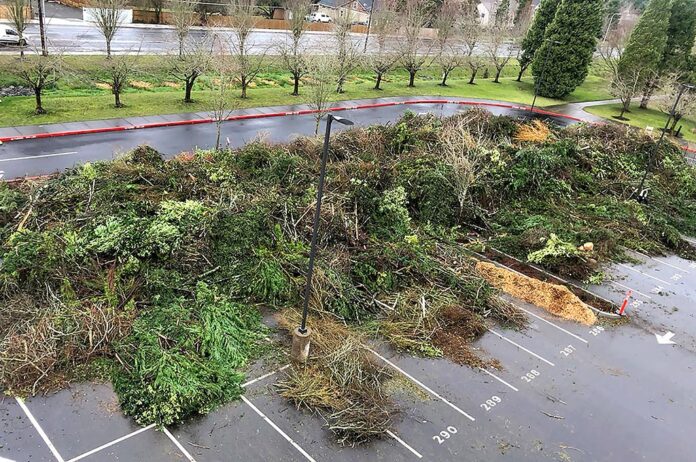
The large winter storm that swept across northwest Oregon over the weekend of Feb. 11-14 not only dumped over a foot of snow in some areas it brought a damaging layer of ice that crushed the local electrical grid.
The storm left well over a half-million people without power throughout the northern Willamette Valley and as far east as Hood River as layer upon layer of freezing rain left sheets of ice coating roadways, trees and power lines. Innumerable trees were damaged or destroyed, along with the utility poles and other infrastructure, leaving a swath of damage that caused Portland General Electric to call on mutual aid agreements with utility partners from as far away as Montana and Nevada. At one point, over 3,000 workers were engaged in this effort.
PGE President Maria Pope called the storm “historic” and “the worst in 40 years” at a virtual press conference held Wednesday, Feb. 17.
“We tripled the size of our workforce … and worked at historic levels through the weekend,” Pope said. “The staggered effect of these storms caused unique complexity to our restoration efforts, and ice on Sunday (Feb. 14) brought down thousands of trees that further set us back and caused thousands of customers to be out of power.”
Many residents of Washington, Multnomah and Clackamas counties experienced more than one power outage as crews scrambled to repair damaged sub-stations, transmission facilities, downed utility poles and damaged power lines. As crews prioritized restoring power to critical public safety infrastructure, including hospitals and water treatment facilities, residential customers were forced to wait their turn for the lights to come back on.
In Tualatin, the ice storm had a particularly severe effect on trees and shrubbery, as well as the electric infrastructure. According to the City of Tualatin, an emergency operations center was activated to organize the City’s response to the storm. Once it had passed and cleanup was started, City crews prioritized clearing roadways of the piles of hazards and debris that had accumulated.
Some of the most hard-hit areas, according to the Public Works Department, included portions of Ibach Street, the portion of SW 50th Ave. where it transitions to SW Wilke Road, SW Nyberg Lane, SW 108th Ave., SW 105th Ave., SW Helenius Street, and SW Boones Ferry Road. It took until Feb. 19 for all major arterial roads to be cleared of debris, after which City employees were able to turn their attention to equally hard-hit neighborhoods.
To assist with residential debris removal, the City made four drop-off sites available between Feb. 18-22 in areas worst hit by the storm. This included a large site at Tualatin High School, where at one point, 27 vehicles were reportedly queued up to drop off debris. Over 60 volunteers, many from Tualatin’s Community Emergency Response Teams, assisted in the cleanup, which continued through March 1.
It’s unlikely that Washington County residents will soon forget this event, which left some residents without power well into the following week.
PGE Utility Operations Director Dale Goodman said that over 130 contract crews were shipped in to assist PGE personnel in restoring the hundreds of transmission lines and substations that failed during the storm.
“Every field employee is out there safely working in some of the most dangerous conditions we’ve ever faced in the history of PGE,” Goodman said at the Feb. 17 press conference. “We have tree limbs, wires down, vegetation issues to clear, and our crews are going through areas that are impassable. They really are working as hard as they possibly can to get power back on for our customers. It was a heroic effort to get our transmission system back up to where it is today.”

















